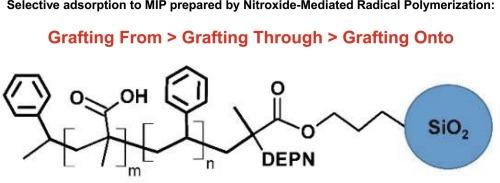Nitroxide-mediated polymerization of methacrylic acid onto silica nanoparticles for the preparation of molecularly imprinted materials
IF 6.3
2区 化学
Q1 POLYMER SCIENCE
引用次数: 0
Abstract
A new approach was investigated for the synthesis of molecularly imprinted polymers (MIPs) for the selective adsorption of 3,5-dichloro-2-hydroxyacetophenone (DCHA). This method involved poly(methacrylic acid-co-styrene) P(MAA-co-S) layers attached to the surface of silica particles utilizing polymers with either high or low molar masses grown on silica nanoparticles. Nitroxide mediated radical polymerization using a N-tert-butyl-N-[1-diethylphosphono-(2,2-dimethylpropyl)] based nitroxide as a control agent was combined with both “grafting onto” and “grafting through” surface modification techniques. The resulting P(MAA-co-S)-grafted silica nanoparticles showed excellent colloidal stability and dispersibility in 1,4-dioxane. DCHA-imprinted materials along with their non-imprinted counterparts were prepared by using ethylene glycol dimethacrylate as the cross-linker. The adsorption properties of these materials were evaluated and modeled by the Volmer and Langmuir–Volmer adsorption models. It was found that the materials synthesized with high molar mass polymers exhibited greater DCHA uptake compared to those with low molar mass; however, the low molar mass materials showed superior adsorption selectivity.

甲基丙烯酸在二氧化硅纳米颗粒上的氮氧化物介导聚合制备分子印迹材料
研究了一种用于选择性吸附3,5-二氯-2-羟基苯乙酮的分子印迹聚合物(MIPs)的合成方法。该方法利用在二氧化硅纳米颗粒上生长的高或低摩尔质量的聚合物,将聚(甲基丙烯酸-co-苯乙烯)P(MAA-co-S)层附着在二氧化硅颗粒表面。以n -叔丁基- n -[1-二乙基膦-(2,2-二甲基丙基)]基氮氧化物为控制剂,采用“接枝”和“透接”两种表面改性技术进行了氮氧化物介导的自由基聚合。得到的P(MAA-co-S)接枝二氧化硅纳米颗粒在1,4-二氧六环中表现出良好的胶体稳定性和分散性。以二甲基丙烯酸乙二醇酯为交联剂制备了dcha印迹材料和非印迹材料。利用Volmer和Langmuir-Volmer吸附模型对这些材料的吸附性能进行了评价和建模。结果表明,与低摩尔质量聚合物相比,高摩尔质量聚合物合成的材料具有更大的DCHA吸收量;而低摩尔质量材料表现出较好的吸附选择性。
本文章由计算机程序翻译,如有差异,请以英文原文为准。
求助全文
约1分钟内获得全文
求助全文
来源期刊

European Polymer Journal
化学-高分子科学
CiteScore
9.90
自引率
10.00%
发文量
691
审稿时长
23 days
期刊介绍:
European Polymer Journal is dedicated to publishing work on fundamental and applied polymer chemistry and macromolecular materials. The journal covers all aspects of polymer synthesis, including polymerization mechanisms and chemical functional transformations, with a focus on novel polymers and the relationships between molecular structure and polymer properties. In addition, we welcome submissions on bio-based or renewable polymers, stimuli-responsive systems and polymer bio-hybrids. European Polymer Journal also publishes research on the biomedical application of polymers, including drug delivery and regenerative medicine. The main scope is covered but not limited to the following core research areas:
Polymer synthesis and functionalization
• Novel synthetic routes for polymerization, functional modification, controlled/living polymerization and precision polymers.
Stimuli-responsive polymers
• Including shape memory and self-healing polymers.
Supramolecular polymers and self-assembly
• Molecular recognition and higher order polymer structures.
Renewable and sustainable polymers
• Bio-based, biodegradable and anti-microbial polymers and polymeric bio-nanocomposites.
Polymers at interfaces and surfaces
• Chemistry and engineering of surfaces with biological relevance, including patterning, antifouling polymers and polymers for membrane applications.
Biomedical applications and nanomedicine
• Polymers for regenerative medicine, drug delivery molecular release and gene therapy
The scope of European Polymer Journal no longer includes Polymer Physics.
 求助内容:
求助内容: 应助结果提醒方式:
应助结果提醒方式:


